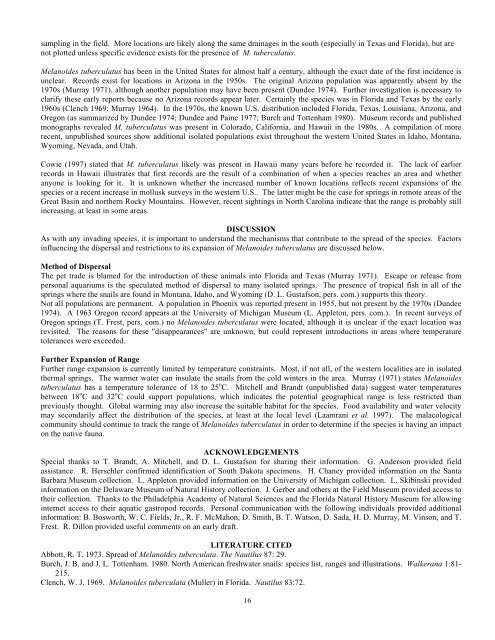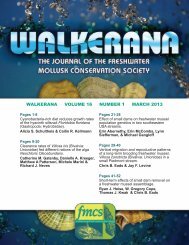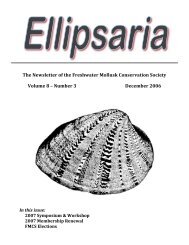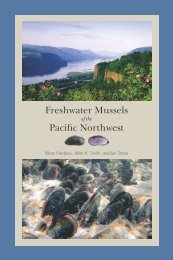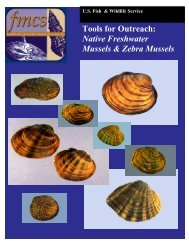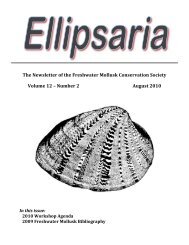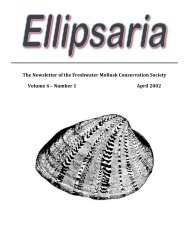August 2004 - FMCS-Freshwater Mollusk Conservation
August 2004 - FMCS-Freshwater Mollusk Conservation
August 2004 - FMCS-Freshwater Mollusk Conservation
You also want an ePaper? Increase the reach of your titles
YUMPU automatically turns print PDFs into web optimized ePapers that Google loves.
sampling in the field. More locations are likely along the same drainages in the south (especially in Texas and Florida), but are<br />
not plotted unless specific evidence exists for the presence of M. tuberculatus.<br />
Melanoides tuberculatus has been in the United States for almost half a century, although the exact date of the first incidence is<br />
unclear. Records exist for locations in Arizona in the 1950s. The original Arizona population was apparently absent by the<br />
1970s (Murray 1971), although another population may have been present (Dundee 1974). Further investigation is necessary to<br />
clarify these early reports because no Arizona records appear later. Certainly the species was in Florida and Texas by the early<br />
1960s (Clench 1969; Murray 1964). In the 1970s, the known U.S. distribution included Florida, Texas, Louisiana, Arizona, and<br />
Oregon (as summarized by Dundee 1974; Dundee and Paine 1977; Burch and Tottenham 1980). Museum records and published<br />
monographs revealed M. tuberculatus was present in Colorado, California, and Hawaii in the 1980s. A compilation of more<br />
recent, unpublished sources show additional isolated populations exist throughout the western United States in Idaho, Montana,<br />
Wyoming, Nevada, and Utah.<br />
Cowie (1997) stated that M. tuberculatus likely was present in Hawaii many years before he recorded it. The lack of earlier<br />
records in Hawaii illustrates that first records are the result of a combination of when a species reaches an area and whether<br />
anyone is looking for it. It is unknown whether the increased number of known locations reflects recent expansions of the<br />
species or a recent increase in mollusk surveys in the western U.S.. The latter might be the case for springs in remote areas of the<br />
Great Basin and northern Rocky Mountains. However, recent sightings in North Carolina indicate that the range is probably still<br />
increasing, at least in some areas.<br />
DISCUSSION<br />
As with any invading species, it is important to understand the mechanisms that contribute to the spread of the species. Factors<br />
influencing the dispersal and restrictions to its expansion of Melanoides tuberculatus are discussed below.<br />
Method of Dispersal<br />
The pet trade is blamed for the introduction of these animals into Florida and Texas (Murray 1971). Escape or release from<br />
personal aquariums is the speculated method of dispersal to many isolated springs. The presence of tropical fish in all of the<br />
springs where the snails are found in Montana, Idaho, and Wyoming (D. L. Gustafson, pers. com.) supports this theory.<br />
Not all populations are permanent. A population in Phoenix was reported present in 1955, but not present by the 1970s (Dundee<br />
1974). A 1963 Oregon record appears at the University of Michigan Museum (L. Appleton, pers. com.). In recent surveys of<br />
Oregon springs (T. Frest, pers. com.) no Melanoides tuberculatus were located, although it is unclear if the exact location was<br />
revisited. The reasons for these "disappearances" are unknown, but could represent introductions in areas where temperature<br />
tolerances were exceeded.<br />
Further Expansion of Range<br />
Further range expansion is currently limited by temperature constraints. Most, if not all, of the western localities are in isolated<br />
thermal springs. The warmer water can insulate the snails from the cold winters in the area. Murray (1971) states Melanoides<br />
tuberculatus has a temperature tolerance of 18 to 25 o C. Mitchell and Brandt (unpublished data) suggest water temperatures<br />
between 18 o C and 32 o C could support populations, which indicates the potential geographical range is less restricted than<br />
previously thought. Global warming may also increase the suitable habitat for the species. Food availability and water velocity<br />
may secondarily affect the distribution of the species, at least at the local level (Laamrani et al. 1997). The malacological<br />
community should continue to track the range of Melanoides tuberculatus in order to determine if the species is having an impact<br />
on the native fauna.<br />
ACKNOWLEDGEMENTS<br />
Special thanks to T. Brandt, A. Mitchell, and D. L. Gustafson for sharing their information. G. Anderson provided field<br />
assistance. R. Herschler confirmed identification of South Dakota specimens. H. Chaney provided information on the Santa<br />
Barbara Museum collection. L. Appleton provided information on the University of Michigan collection. L. Skibinski provided<br />
information on the Delaware Museum of Natural History collection. J. Gerber and others at the Field Museum provided access to<br />
their collection. Thanks to the Philadelphia Academy of Natural Sciences and the Florida Natural History Museum for allowing<br />
internet access to their aquatic gastropod records. Personal communication with the following individuals provided additional<br />
information: B. Bosworth, W. C. Fields, Jr., R. F. McMahon, D. Smith, B. T. Watson, D. Sada, H. D. Murray, M. Vinson, and T.<br />
Frest. R. Dillon provided useful comments on an early draft.<br />
LITERATURE CITED<br />
Abbott, R. T. 1973. Spread of Melanoides tuberculata. The Nautilus 87: 29.<br />
Burch, J. B. and J. L. Tottenham. 1980. North American freshwater snails: species list, ranges and illustrations. Walkerana 1:81-<br />
215.<br />
Clench, W. J. 1969. Melanoides tuberculata (Muller) in Florida. Nautilus 83:72.<br />
16


